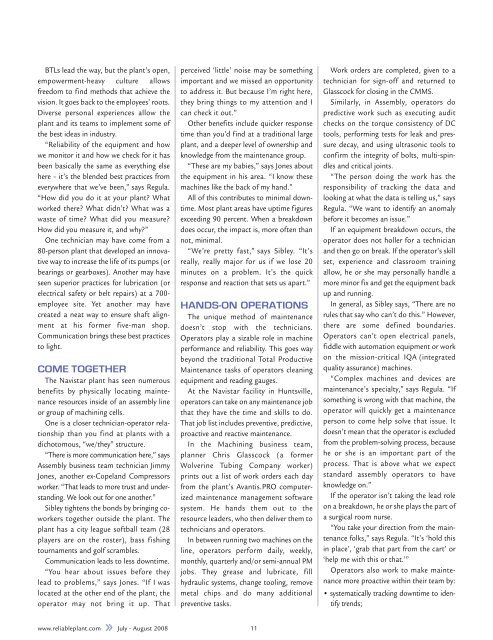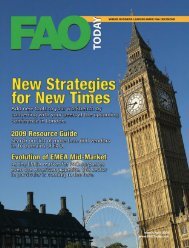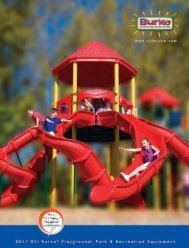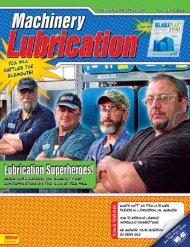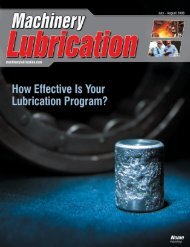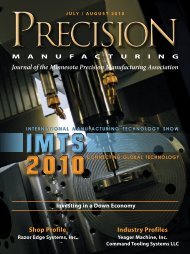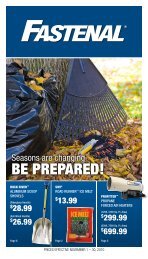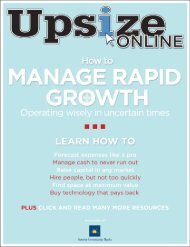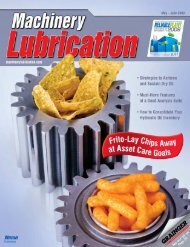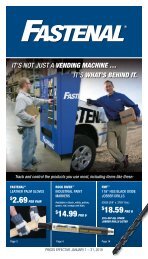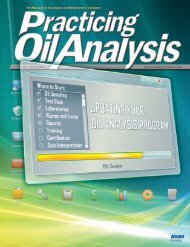Reliable Plant July August 2008
Reliable Plant July August 2008
Reliable Plant July August 2008
Create successful ePaper yourself
Turn your PDF publications into a flip-book with our unique Google optimized e-Paper software.
BTLs lead the way, but the plant’s open,<br />
empowerment-heavy culture allows<br />
freedom to find methods that achieve the<br />
vision. It goes back to the employees’ roots.<br />
Diverse personal experiences allow the<br />
plant and its teams to implement some of<br />
the best ideas in industry.<br />
“Reliability of the equipment and how<br />
we monitor it and how we check for it has<br />
been basically the same as everything else<br />
here – it’s the blended best practices from<br />
everywhere that we’ve been,” says Regula.<br />
“How did you do it at your plant? What<br />
worked there? What didn’t? What was a<br />
waste of time? What did you measure?<br />
How did you measure it, and why?”<br />
One technician may have come from a<br />
80-person plant that developed an innovative<br />
way to increase the life of its pumps (or<br />
bearings or gearboxes). Another may have<br />
seen superior practices for lubrication (or<br />
electrical safety or belt repairs) at a 700-<br />
employee site. Yet another may have<br />
created a neat way to ensure shaft alignment<br />
at his former five-man shop.<br />
Communication brings these best practices<br />
to light.<br />
COME TOGETHER<br />
The Navistar plant has seen numerous<br />
benefits by physically locating maintenance<br />
resources inside of an assembly line<br />
or group of machining cells.<br />
One is a closer technician-operator relationship<br />
than you find at plants with a<br />
dichotomous, “we/they” structure.<br />
“There is more communication here,” says<br />
Assembly business team technician Jimmy<br />
Jones, another ex-Copeland Compressors<br />
worker. “That leads to more trust and understanding.<br />
We look out for one another.”<br />
Sibley tightens the bonds by bringing coworkers<br />
together outside the plant. The<br />
plant has a city league softball team (28<br />
players are on the roster), bass fishing<br />
tournaments and golf scrambles.<br />
Communication leads to less downtime.<br />
“You hear about issues before they<br />
lead to problems,” says Jones. “If I was<br />
located at the other end of the plant, the<br />
operator may not bring it up. That<br />
perceived ‘little’ noise may be something<br />
important and we missed an opportunity<br />
to address it. But because I’m right here,<br />
they bring things to my attention and I<br />
can check it out.”<br />
Other benefits include quicker response<br />
time than you’d find at a traditional large<br />
plant, and a deeper level of ownership and<br />
knowledge from the maintenance group.<br />
“These are my babies,” says Jones about<br />
the equipment in his area. “I know these<br />
machines like the back of my hand.”<br />
All of this contributes to minimal downtime.<br />
Most plant areas have uptime figures<br />
exceeding 90 percent. When a breakdown<br />
does occur, the impact is, more often than<br />
not, minimal.<br />
“We’re pretty fast,” says Sibley. “It’s<br />
really, really major for us if we lose 20<br />
minutes on a problem. It’s the quick<br />
response and reaction that sets us apart.”<br />
HANDS-ON OPERATIONS<br />
The unique method of maintenance<br />
doesn’t stop with the technicians.<br />
Operators play a sizable role in machine<br />
performance and reliability. This goes way<br />
beyond the traditional Total Productive<br />
Maintenance tasks of operators cleaning<br />
equipment and reading gauges.<br />
At the Navistar facility in Huntsville,<br />
operators can take on any maintenance job<br />
that they have the time and skills to do.<br />
That job list includes preventive, predictive,<br />
proactive and reactive maintenance.<br />
In the Machining business team,<br />
planner Chris Glasscock (a former<br />
Wolverine Tubing Company worker)<br />
prints out a list of work orders each day<br />
from the plant’s Avantis.PRO computerized<br />
maintenance management software<br />
system. He hands them out to the<br />
resource leaders, who then deliver them to<br />
technicians and operators.<br />
In between running two machines on the<br />
line, operators perform daily, weekly,<br />
monthly, quarterly and/or semi-annual PM<br />
jobs. They grease and lubricate, fill<br />
hydraulic systems, change tooling, remove<br />
metal chips and do many additional<br />
preventive tasks.<br />
Work orders are completed, given to a<br />
technician for sign-off and returned to<br />
Glasscock for closing in the CMMS.<br />
Similarly, in Assembly, operators do<br />
predictive work such as executing audit<br />
checks on the torque consistency of DC<br />
tools, performing tests for leak and pressure<br />
decay, and using ultrasonic tools to<br />
confirm the integrity of bolts, multi-spindles<br />
and critical joints.<br />
“The person doing the work has the<br />
responsibility of tracking the data and<br />
looking at what the data is telling us,” says<br />
Regula. “We want to identify an anomaly<br />
before it becomes an issue.”<br />
If an equipment breakdown occurs, the<br />
operator does not holler for a technician<br />
and then go on break. If the operator’s skill<br />
set, experience and classroom training<br />
allow, he or she may personally handle a<br />
more minor fix and get the equipment back<br />
up and running.<br />
In general, as Sibley says, “There are no<br />
rules that say who can’t do this.” However,<br />
there are some defined boundaries.<br />
Operators can’t open electrical panels,<br />
fiddle with automation equipment or work<br />
on the mission-critical IQA (integrated<br />
quality assurance) machines.<br />
“Complex machines and devices are<br />
maintenance’s specialty,” says Regula. “If<br />
something is wrong with that machine, the<br />
operator will quickly get a maintenance<br />
person to come help solve that issue. It<br />
doesn’t mean that the operator is excluded<br />
from the problem-solving process, because<br />
he or she is an important part of the<br />
process. That is above what we expect<br />
standard assembly operators to have<br />
knowledge on.”<br />
If the operator isn’t taking the lead role<br />
on a breakdown, he or she plays the part of<br />
a surgical room nurse.<br />
“You take your direction from the maintenance<br />
folks,” says Regula. “It’s ‘hold this<br />
in place’, ‘grab that part from the cart’ or<br />
‘help me with this or that.’”<br />
Operators also work to make maintenance<br />
more proactive within their team by:<br />
• systematically tracking downtime to identify<br />
trends;<br />
www.reliableplant.com <strong>July</strong> - <strong>August</strong> <strong>2008</strong> 11


